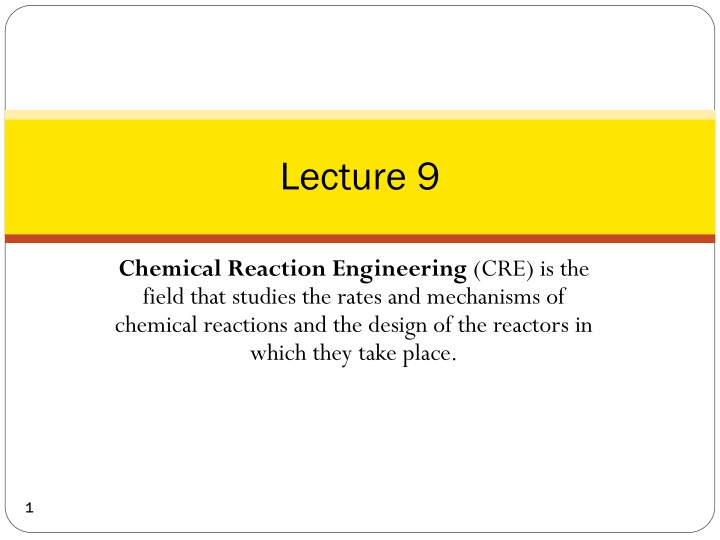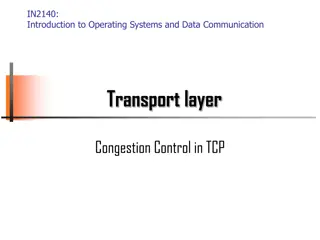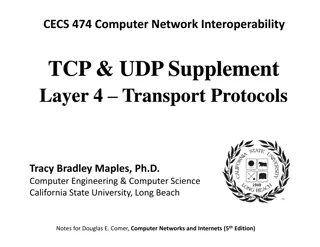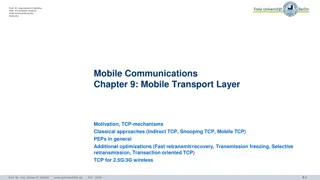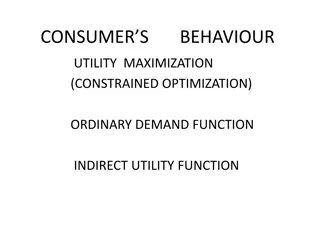Network Utility Maximization in TCP Networks
In this content, the focus is on TCP (Transmission Control Protocol) networks and how they solve the optimization problem of network utility maximization. Through illustrations and examples, the lecture delves into TCP's role in maximizing utility and optimizing rate allocation. The concept of utility functions, log(x), and rate allocation constraints are explored, shedding light on the key issues addressed in TCP networks. The lecture also hints at the significant impact and research interest sparked by TCP's optimization capabilities.
Download Presentation

Please find below an Image/Link to download the presentation.
The content on the website is provided AS IS for your information and personal use only. It may not be sold, licensed, or shared on other websites without obtaining consent from the author.If you encounter any issues during the download, it is possible that the publisher has removed the file from their server.
You are allowed to download the files provided on this website for personal or commercial use, subject to the condition that they are used lawfully. All files are the property of their respective owners.
The content on the website is provided AS IS for your information and personal use only. It may not be sold, licensed, or shared on other websites without obtaining consent from the author.
E N D
Presentation Transcript
Lecture 9 Chemical Reaction Engineering (CRE) is the field that studies the rates and mechanisms of chemical reactions and the design of the reactors in which they take place. 1 1
Lecture 9 Lecture 9 Thursday 2/7/2013 Thursday 2/7/2013 Balances in terms of molar flow rates Block 1: Mole Balances Balance Equation on Every Species Block 2: Rate Laws Relative Rates Transport Laws Block 3: Stoichiometry Block 4: Combine Membrane Reactors: Used for thermodynamically limited reactions 2 2
Review Lecture 1 Reactor Reactor Mole Balances Mole Balances Summary Summary The GMBE applied to the four major reactor types (and the general reaction A B) Reactor Differential Algebraic Integral NA ????? ??? ??? ?? Batch ? = = ??? ??0 t V=??0 ?? CSTR ?? FA ????? ??? ??? ??= ?? PFR ? = ??0 V FA ????? ??? ??= ? ? PBR ? = ?? ??0 3 3 W
Membrane Reactors Membrane reactors can be used to achieve conversions greater than the original equilibrium value. These higher conversions are the result of Le Chatelier s principle; you can remove the reaction products and drive the reaction to the right. To accomplish this, a membrane that is permeable to that reaction product, but impermeable to all other species, is placed around the reacting mixture. 5
Membrane Reactors Dehydrogenation Reaction: C3H8 H2+ C3H6 A B + C Thermodynamically Limited: exothermic Xe Xe XEB T 6
Membrane Reactors Cross section of IMRCF Membrane Reactors Cross section of CRM Schematic of IMRCF for mole balance 7
Membrane Reactors sweep B W = bV = solids weight b= (1- ) C= bulk solids density C = density of solids FA0 A,B,C B ??=?????? ?????? ?????? ????? ???? ?? ?????? ?????? ?????? H2 H2 CBS CB A,C stay behind since they are too big 8
Membrane Reactors Mole Balance on Species A: Species A: In out + generation = 0 ??? ???+ ?+ ?? ? = 0 ??? ??= ?? 9
Membrane Reactors Mole Balance on Species B: Species B: In out out membrane + generation = 0 ??? ???+ ? ?? ? + ?? ? = 0 ??? ??= (?? ??) ??=moles of B through sides volume of reactor 10
Membrane Reactors (?? ???) =molar flow rate through membrane surface area of membrane ??? ?2 ? ??= ?? ?2 ?3 ? =membrane surface area reactor volume ??? ??2 4 =4 = ? ? ? ?? ??? ??= ??? = ?? ? ??= ?? ??? ?3 ? ??= ???? ??? Neglected most of the time 11
Membrane Reactors Mole Balances: ??? ??= ?? 1 ??? ??= ?? ?? 2 ??? ??= ?? 3 Rate Law: ??= ? ?? ???? 4 ?? 12
Membrane Reactors ?? 1 =?? 1=?? Relative Rates: 1 Net Rates: Transport Law: 5 ??= ??, ??= ?? 6 ??= ???? ?? ?? Stoichiometry: 7 ??= ??0 (isothermal, isobaric) ?? ?? 8 ??= ??0 ?? ?? 9 ??= ??0 10 ??= ??+ ??+ ?? Parameters: CTO = 0.2, FA0= 5, k = 4, KC = 0.0004, kC= 8 13
Membrane Reactors Example: The following reaction is to be carried out isothermally in a membrane reactor with no pressure drop. The membrane is permeable to product C, but impermeable to all other species. Inert Sweep Gas H2 (C) C6H12 C6H6+ 3H2 A B+ 3C C6H12 (A) C6H6 (B) Inert Sweep Gas For membrane reactors, we cannot use conversion. We have to work in terms of the molar flow rates FA, FB, FC. 14
Membrane Reactors C6H12 C6H6+ 3H2 A B+ 3C Mole Balances ??? ??= ?? Inert Sweep Gas H2 (C) ??? ??= ?? C6H12 (A) C6H6 (B) ??? ??= ?? ???? Inert Sweep Gas 15
Membrane Reactors 3 ?? = ???? ???? Rate Law: ?? ?? 1=?? =?? Relative Rates: 1 3 Net Rates: ?? = ?? ?? = 3?? 16 16
Membrane Reactors Stoichiometry: Isothermal, no Pressure Drop ?0 ??0 ??0= ?? ?? ??= ??0 ?? ?? ??= ??0 ?? ?? ??= ??0 ??= ??+ ??+ ?? 17 17
Membrane Reactors Combine: - Use Polymath ??0= 0.2??? ??0= 10??? Parameters: ??3 ? ??3 ?? ??? ? ??3 ?? ??? ? ??= 10 ??= 0.5 ??= 200???2 ??6 18 18
Membrane Reactors C6H12 (A) C6H6 (B) Ci H2 (C) W 19 19
End of Lecture 9 20 20
